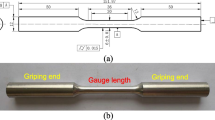Abstract
We study the mechanism of fatigue cracking of the matrix of cross-ply carbon-epoxy laminates. Primary attention is given to the study of the influence of the specimen width on the evolution of damage. On the basis of shear lag analysis, we determine the strain energy release rate in the processes of initiation and growth of transverse fatigue cracks. We also present results of experimental research on the evolution of the edge crack density per ply, the average length of the cracks, and the crack propagation rate under transverse fatigue cracking. It is shown that these characteristics are independent of the specimen width. At the same time, as soon as the edge crack density reaches its saturation value, the average crack growth rate becomes constant. All the experimental results are in good agreement with results obtained by using the theoretical model.
Similar content being viewed by others
References
L. Boniface, P. A. Smith, S. L. Ogin, and M. G. Bader, “Observations on transverse ply crack growth in a [0/902] s CFRP laminate under monotonic and cyclic loading,” in:Proceedings of ICCM and ECCM2, Vol. 3, London, (1987), pp. 156–165.
M. Caslini, C. Zanotti, and T. K. O'Brien,J. Comp. Techn. Research,9, No. 4, 121–130 (1987).
C. Henaff-Gardin, M. C. Lafarie-Frenot, J. Brillaud, and A. El. Mahi, “Influence of the stacking sequence on fatigue transverse ply cracking in cross-ply composite laminates,” in:Damage Detection in Composite Materials (ASTM STP 1128), Philadelphia (1992).
M. C. Lafarie-Frenot and J. M. Riviére, “Mécanismes d'endommagement par fatigue d'un composite stratifié à fibres longues: étude la fissuration transverse,” in:Proc. 6èmes Journées Nationales des Composites, Paris (1988), pp. 635–647.
M. C. Lafarie-Frenot and C. Henaff-Gardin,Comp. Sci. Tech.,40, No. 3, 307–324 (1991).
S. L. Ogin, P. A. Smith, and P. W. R. Beaumont,Transverse Ply Crack Growth and Associated Reduction during the Fatigue of a Simple Cross-Ply Laminate, Cambridge University, Eng. Dept. (CUED/MATS/TR. 105) (1984).
S. L. Ogin and P. A. Smith,Scr. Met.,19, 779–784 (1985).
K. L. Reifsnider, “Some fundamental aspects of the fatigue and fracture response of composite materials,” in:Proceedings of the 14th Annual Meeting of the Society of Engineering Sciences, Bethleem (1977), pp. 373–384.
W. W. Stinchcomb and K. L. Reifsnider, “Fatigue damage mechanisms in composite materials: a review,” in: J. T. Fong (editor),Fatigue Mechanics (ASTM STP 675), Philadelphia (1979), pp. 762–787.
Additional information
Laboratoire de Mecanique et de Physique des Materiaux ENSMA, Poitiers Cedex, France. Published in Fiziko-Khimicheskaya Mekhanika Materialov, Vol. 30, No. 1, pp. 109–112, January–February, 1994.
Rights and permissions
About this article
Cite this article
Henaff-Gardin, C., Urwald, E. & Lafarie-Frenot, M.C. Simulation of 90° ply fatigue crack growth along the width of cross-ply carbon-epoxy coupons. Mater Sci 30, 110–114 (1995). https://doi.org/10.1007/BF00559025
Received:
Issue Date:
DOI: https://doi.org/10.1007/BF00559025




